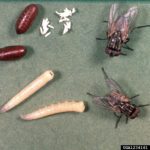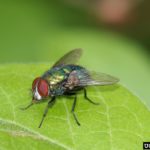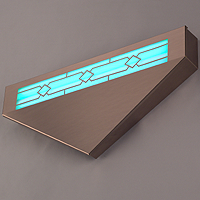General Information
 Flies such as house flies, little house flies, dump flies, blow flies, and blue and green bottle flies which breed in food wastes (garbage) and/or animal feces are generally referred to as “filth flies.” House flies are one of the most common flies infesting dumpsters, manure and other vegetable waste. Other flies, such as stable flies, breed in decaying vegetable matter such as grass cuttings. Flies that invade cafeterias and kitchens are not only a nuisance; they also present a health hazard because they can contaminate food, utensils, and surfaces. Biting flies, such as stable flies, can inflict painful bites.
Flies such as house flies, little house flies, dump flies, blow flies, and blue and green bottle flies which breed in food wastes (garbage) and/or animal feces are generally referred to as “filth flies.” House flies are one of the most common flies infesting dumpsters, manure and other vegetable waste. Other flies, such as stable flies, breed in decaying vegetable matter such as grass cuttings. Flies that invade cafeterias and kitchens are not only a nuisance; they also present a health hazard because they can contaminate food, utensils, and surfaces. Biting flies, such as stable flies, can inflict painful bites.
Houseflies in some areas can be a potential health and nuisance problem in schools. They pose a health problem because of their ability to carry pathogens from their breeding and feeding sites (manure and garbage) to food preparation surfaces and other sites that humans contact by touch. Houseflies are especially a problem in kitchens for this reason. School kitchens and cafeterias with house fly infestations are subject to be closed by health inspectors. Houseflies are also considered a nuisance, especially when homes are situated close to livestock operations such as chicken facilities, and horse and other livestock barns.
When house fly problems occur in buildings or kitchen areas, the most common explanation is improper maintenance and cleaning of nearby garbage receptacles. Effective control of houseflies, as with all flies, depends on locating and eliminating the fly breeding site. Insecticide fogs that kill flying insects provide only temporary relief of flies and do nothing to solve a fly problem, although continuously running light traps can help provide supplemental control of low-level fly problems in kitchens and other sensitive sites.
House and filth fly control in livestock barns can pose special legal issues regarding posting and exposure of students and staff. In particular, use of automatic mister systems can expose students and staff who are in the misting area when the systems turn on. Proper calibration and programming of equipment can minimize this risk; nevertheless, we recommend that the district advise parents of students using the barn about the types of pesticides (e.g., baits, mister systems) in use prior to the school year, or prior to beginning of pesticide use. Notification of when and where pesticides are being applied should be posted in the Ag Education classrooms and at points of entry into the barn facilities using the approved pest control sign for the District.
Identification
| Species | Description | Where to Look | Image |
| House fly, Musca domestica | Adult flies are dull gray with four narrow stripes running the length of the thorax. They are about 1/4 inch long. There is no pale spot behind the head. Mature larvae (maggots) are cream-colored with a pointed head and blunt tail bearing two dark spots (spiracles). Full grown larvae are 1/4-3/8 inch long. | Flies feed on a great variety of foods ranging from excrement to human food. Almost exclusively, breeding occurs outdoors in garbage areas, dumpsters, agricultural barns, fermenting lawn clippings and any other area associated with garbage or excrement. They can transfer disease-causing organisms through mechanical transport and via their feces and regurgitation’s. Females seek warm, moist areas containing material with sufficient food for larval development (e.g., dumpsters) to lay eggs. |
 Multiple Life Stages house fly (Musca domestica) |
| Blow fly, Calliphora sp | Adults are wholly or partially metallic blue, green or a dull brassy color. Sometimes they are black. They are 1/8 inch to 5/8 inch long. Mature larvae (maggots) are pale yellow to white, 3/8-7/8 inch long, eyeless and legless. This fly can sometimes be heard buzzing if caught in a window area. | The larvae usually are found in meat or animal carcasses, but they may be found in animal excrement, decaying vegetation or garbage. Check garbage areas and dumpsters for decayed or fermented food. Eggs are laid in these items, and maggots develop there. A sudden emergence of adults indoors often is associated with a dead animal located within the structure. |
 Adult blow fly (Calliphora sp) on a leaf. |
Suggested Thresholds
Indoors – kitchen area: More than three flies per day or based on single complaint. Outdoor trash or garbage receptacles: Easily visible flies are common and pose a visual nuisance around dumpsters or may generate a single complaint.
Outdoors – School Ag Facilities: Fly speck counts > 100 specks per week on index cards placed in Ag barn at approx. 4-6-foot height. Cards should be checked and replaced weekly.
(Note: Each site will have different nuisance tolerances for flies, based on worker tolerance and proximity to neighborhoods or other areas where fly production is undesirable. Workers, in cooperation with IPM Coordinator, will adjust this suggested threshold to justify turning on aerosol insecticide treatment. This threshold should be reviewed for appropriateness at least once a school year.)
Monitoring and Inspection
It is important to correctly identify problem flies and pinpoint their breeding sites. Some of their characteristics can help you with identification; alternatively, specimens can be taken or sent to a county extension agent who should be able to assist in identification. If they cannot identify the specimen, they will be able to refer you to a specialist who can. To collect specimens inside, use sticky flypaper or gather dead specimens from windowsills and light fixtures. Individual flies captured for identification purposes should be held in a small vial to preserve key identifying characters.
Inspection practices should include ensuring that trash cans or dumpsters are placed away from building entryways; proper use of plastic bag liners in trash cans; all trash disposed in dumpsters enclosed in sealed bags; adequate cleanup of spilled food and drinks; properly sealed openings throughout the building exterior; and tightly fitting doors, door sweeps and window seals.
Nonchemical Control Measures
To manage flies, you must find and reduce breeding sites, install and maintain screens to keep flies out of buildings, kill those flies that do get inside with a fly swatter or flypaper, and reduce or eliminate the odors that attract flies.
In schools that have programs where animal wastes are removed frequently (e.g., twice weekly) and dumpsters are well-maintained, it is unlikely that flies are breeding on the school property. It is more likely that odors from dumpsters, garbage cans, kitchens, and cafeterias are attracting flies to the school from the surrounding neighborhood. House flies and blow flies, the species that most commonly invade buildings, usually develop outside and follow odors into the building. They can also be nuisance pests when students or staff eat outside of the building. In schools where waste removal is infrequent, fly populations can breed at the waste collection site.
Sanitation/Cultural Control Measures
- Manure from Ag barn should be removed at least weekly and disposed of at a site away from school district property, preferably on agricultural land where it does not pose a nuisance or result in groundwater pollution. Alternatively, manure may be composted in an efficient composting operation that generates minimal fly problems. High temperatures (>120 degrees F) generated by efficient composting will kill all immature life stages.
- Empty trash at least once or twice a week
- Replace or clean outside dumpsters or identify and remove other fly breeding sites outdoors.
- Doors to the outside should remain closed between use throughout the day and evening.
- Garbage dumpsters should be located at least 50 feet away from all kitchen doorways or window
- Inform students, teachers, and staff of the importance of placing garbage inside the proper containers. Garbage should not be left lying on the ground.
- Place exterior trashcans and dumpsters away from building entrances. To avoid attracting flies into the building, place dumpsters and recycling containers upwind from the outside doors of the school, particularly for the doors to the kitchen or cafeteria. When dumpsters are downwind, flies are attracted to the waste odors and then find the odor trails that the breeze blows down from the doorways. Following these odor trails, they find their way into the building.
- Properly clean and maintain exterior drains in trash handling areas including loading docks and indoor floor drains to avoid accumulation of organic matter and liquid.
- Flies can develop in soil soaked with water used to clean garbage cans and dumpsters. Check these areas regularly. If you see maggots, scrape them up along with the soil and dispose of everything in a plastic bag sealed tightly.
Physical/Mechanical Control Measures
- Install fly traps and/or air curtains in kitchen area. Makes sure the air blows out and not into the kitchen. Electronic fly traps

Insect fly lights are most effective when they are placed between 4 to 6 feet high. They are good monitors for flying insects.
should be of non-electrocuting design to avoid contaminating kitchen surfaces; they should be placed at 4-6 feet high and should not be visible from the outside at any time to avoid drawing flies indoors. Light bulbs used in such traps may appear to be functioning correctly yet be producing inadequate UV light emission for optimal fly control. Bulbs should be replaced in all fly light traps annually.
- Replace or clean dumpster. Ensure that lids are tight-fitting to minimize garbage odors
- Replace or clean trash receptacle. Install tight-fitting, spring-loaded lid that closes after use to minimize odors and discourage fly entry. Empty trash daily
- Remove individual flies using flyswatters, fly paper or appropriate indoor light traps. Do not place flypaper or sticky strips above or near food preparation areas.
- All food waste from the kitchen, cafeteria and other areas should be separated from other garbage, drained so it will be as dry as possible and then stored in sealed plastic bags before discarding. Place containers with small amounts of food waste, such as milk or yogurt cartons, into sealed plastic bags before disposal.
- Plastic bags used for waste disposal should be thick enough to avoid tearing or puncturing by insects such as yellow jackets.
- Promptly fix drains or electric garbage disposal units that leak or drains that allow food waste to accumulate under sinks or floors. Leaky drains can attract many species of flies. Remove any food waste that has accumulated under sinks or floors or in crawl spaces or basements at the site of the broken drain, and then clean the area thoroughly.
- In food preparation areas, rinse all cans, bottles, and plastic containers before recycling or discarding.
Chemical Control Measures
While chemical pesticides may be effective for suppressing adult fly populations in some situations, they are not a substitute for proper sanitation and aggressive elimination of nuisance-fly-development sites.
In most school situations, pesticides are not needed or recommended for fly management. Sanitation along with exclusion to keep flies out should be sufficient. In rare cases where non-chemical methods are not possible or effective, a non-residual aerosol may be used to knock down flies. This is only a temporary measure and should only be done in combination with other non-chemical, sanitary measures. Non-chemical measures should be sufficient. No pesticides for fly control are generally needed in kitchens.
Outside, a residual insecticide may be applied to surfaces such as walls and overhangs that are being used by the flies as resting areas. Fly baits used in trash or other areas may be effective in reducing the number of adult flies if proper sanitation practices are followed. However, when flies have access to garbage, baits will not effectively control them.
For outdoor ag barn location, baits can be placed in an inaccessible location. Fly bait, such as QuikBayt (or Golden Malrin-both are toxic and should be used only in areas inaccessible to students) can be painted on out-of-reach surfaces or placed (granular form) in hanging containers out of reach of children and livestock. Always read and follow the label. The label is the law. Pesticides must be used in accordance with federal, state and local regulations. Applicators must have proper credentialing to apply pesticides and should always wear personal protective equipment (PPE) as required by the pesticide label during applications. All labels and Safety Data Sheets (SDS) for the pesticide products authorized for use in the IPM program should be maintained on file.
Fly misting systems are not generally recommended for use in school settings and should never be used in enclosed buildings. If installed, they should be used only when fly populations exceed the agreed-upon threshold. Mister systems must be programmed to activate only when students and staff are not present. All directions and safety requirements on pesticide containers must be followed at all times. The preferred active ingredient in mister systems is botanical pyrethrins, because of this product’s low toxicity and rapid breakdown in the environment.
Evaluation Methods
Area will need to be monitored periodically to ensure adoption of non-chemical control measures.
Compiled from publications by Mike Merchant and Sonja Swiger
